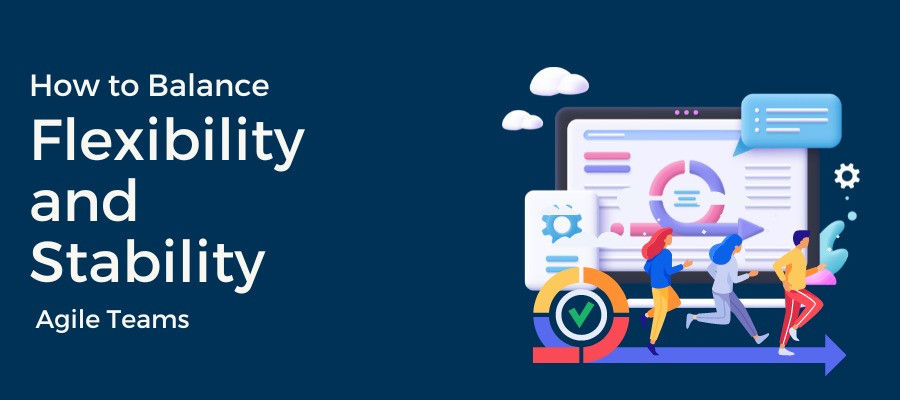How to Balance Flexibility and Stability in Agile Teams: Tips for Scrum Masters

Scrum is an iterative software development and product management method that embodies Agile principles. It emphasizes handling project development in short iterations to facilitate business and engineering flexibility, aiming to provide continuous value to customers. This approach is beneficial for managing long-term, complex projects that require adaptability from both business and engineering perspectives.
In this blog, we will outline the key components of Scrum and share some best practices for Scrum Masters to optimize the Scrum process. We will focus on balancing flexibility and stability in Agile teams, which is critical for successful project management. By following these tips, Scrum Masters can help their teams achieve better results and enhance customer satisfaction.
Best Practices for Teamwork and Meetings in Agile Teams
- Collaborate with stakeholders to create the product backlog and vision
To ensure that the Scrum team understands the stakeholder's vision, filling the product backlog with stakeholders is essential. This can be done even before signing a contract. Collaborating on the product backlog allows the team to align their vision with stakeholders and reach a mutual understanding of the future product.
- Invite stakeholders to Scrum meetings
To improve stakeholder involvement and understanding of the team's communication, inviting stakeholders or product owners to some Scrum meetings is essential. By doing so, stakeholders can assess the team's sprint planning techniques, hear discussions about work results during sprint reviews or demos, and provide valuable feedback about the deliverables and collaboration efforts.
- Keep existing teams together
It's best to avoid regrouping a team that has already been working together on previous projects. These people have learned to collaborate and know each other's working styles. However, different skill sets required for various projects may make it necessary to create new teams.
- Prioritize team building
Team building activities are essential to fostering strong teamwork in any Scrum team, particularly if a new team needs to be formed from scratch. It's critical to focus on not just informal socializing or Scrum games and professional activities that improve collaboration, such as sharing skills and adopting engineering practices. An effective team-building path includes forming and clarifying roles and processes, setting a decision-making workflow, optimizing established relationships, and successfully achieving results.
Tips for Planning and Estimating in Scrum
- Collaborate with Stakeholders to estimate
To ensure accurate estimates for product backlog items, involve stakeholders in the estimation process. This allows the team to ask critical questions and for the stakeholder to better understand how the group arrived at the estimate. Although it may not guarantee perfect estimates, this approach can help establish trust and prevent conflicts.
- Plan Sprints with Enough Product Backlog Items
To avoid scope creep, only plan a new sprint when there are enough items in the product backlog for at least two sprints. This ensures that the scope is defined and the team can focus on delivering the required items without uncontrolled growth in the project scope.
- Set Sprint Goals
Sprint goals are crucial for aligning the team and the customer's objectives. They help prioritize the items in the backlog and guide the team on what to accomplish during a sprint. Product owners should set sprint goals before selecting items for the next sprint, and during sprint planning, the team should choose items according to the plan. Goals should be clear and concise: "Implement the check-out workflow: view the cart, set payment, choose a delivery method, pay, receive a confirmation email."
Efficient Backlog Management for Agile Teams
- Separate Product Backlog and Sprint Backlog for Efficient Sprint Planning
To ensure efficient sprint planning and accurate estimation, keeping the product backlog and sprint backlog separate is essential. While the product backlog is constantly updated, the sprint backlog is typically frozen. By comparing sprint backlogs, teams can measure their velocity and make more precise estimates for future sprints.
- Prioritize Tasks Using Effective Backlog Prioritization Techniques
Using effective backlog prioritization techniques is crucial for successful product development. While some teams rely on HiPPO (The highest-paid person’s opinion), this approach lacks transparency and can hinder data-driven decision-making. Common techniques include:
MoSCoW: A widely used approach categorizes tasks as Must haves, Should haves, Could haves, and Won’t haves based on priority.
Business value: This approach allows stakeholders or product owners to estimate the financial value of user stories, making it highly efficient for validated business ideas.
Technology risks: Prioritizing tasks based on estimated risks can help teams implement the riskiest features first and approach predictable engineering tasks in later sprints.
Kano model: This model classifies customer preferences such as must-have, attractive quality, indifferent quality, and reverse rate, making it ideal for saturated markets.
Walking skeleton: Prioritizing features that are just enough for the product to launch quickly is often used for MVP development.
Validated learning: Prioritizing features with the highest market risk for early release can provide valuable feedback for disruptive market strategies.
Conclusion
It's essential to remember that the Scrum practices and recommendations listed above are not an exhaustive list, nor should they be taken as a one-size-fits-all approach to agile development. Every team and project is unique, and the Scrum practices that work effectively for one group may not be the right fit for another. Context matters, and it's crucial to assess and adapt the Scrum framework to fit your team and project's specific needs and goals.
Reference
- https://www.emerald.com/insight/content/doi/10.1108/IJMPB-12-2020-0366/full/html




